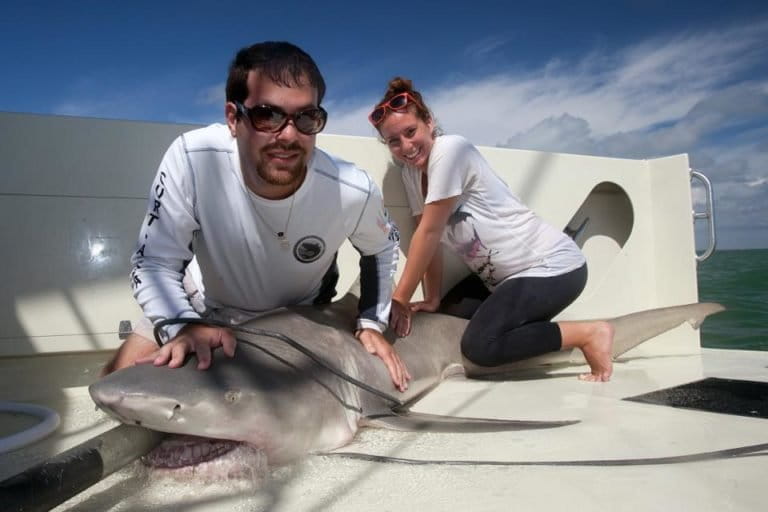- “There are many threats facing sharks, but [finning] gets the most attention,” says David Shiffman.
- Overfishing presents the greatest threat to sharks, not the practice of finning, he says, yet finning gets the most media coverage and that consequently skews popular opinion, and policy.
- An analysis of 10 years of media reports recently published by Shiffman et al in the journal iScience shows that 2/3 of all articles in the media about threats to sharks focused on finning, and the trade in shark fins.
- “The solution overwhelmingly supported by surveyed scientific experts is not banning fishing for sharks and trade in shark products, but making fishing more sustainable,” he says in this conversation with Mongabay.
If there’s one thing most of the public knows about shark conservation, it’s that they’re under siege by global fleets of vessels that scoop them up, cut off their fins and deposit them back into the ocean to drown, a cruel practice known as shark finning.
But what if that practice, while real, isn’t the singular threat it’s made out to be?
“There are many threats facing sharks, but one, which is not the biggest threat, gets the most attention,” says David Shiffman, a postdoctoral researcher at Arizona State University who studies shark conservation.
An analysis of ten years’ worth of media reports, published in June by Shiffman et al in the open-access journal iScience, shows that two-thirds of all articles about threats to sharks focused on finning and the trade in shark fins — two separate issues that are conflated so frequently, write the authors, that “it was impossible to tease these two threats apart.”
A more pressing threat, overfishing, was mentioned in just four of ten articles. Recreational fishing for sharks, which the authors call an emerging threat, only made it into a tenth of the articles.

Critically endangered sharks, meanwhile, got a tiny fraction of the attention of the better-known species, like great white sharks. They showed up just 20 times in nearly 2,000 articles.
The result of the skewed media coverage, Shiffman says, is that “a concerned citizen learning about this important issue from newspapers would be badly misinformed,” which could lead them to support policies that, at best, won’t work.
Mongabay reached Shiffman over email for an interview that’s been edited lightly for length and clarity.
Jimmy Thomson for Mongabay: Why did you want to study how the press portrays threats to sharks?
David Shiffman: As a scientist who studies how to protect threatened shark species and a public science educator who talks to concerned members of the public about these issues, I’ve long noticed a disconnect — the way experts talk about shark conservation threats and solutions is very, very different from how concerned non-experts talk about shark conservation threats and solutions.
There are lots of people who care and want to help, but have wildly wrong understandings of what the threats to sharks are and how to protect sharks. In participatory democracies, that’s a problem because public support is required for policy change. My research program looks at where people learn the wrong things they “know” about sharks, and popular press coverage is a major information pathway.

How did you look into the media coverage?
We used a method called media content and discourse analysis, which is a scientific way to assess what topics are covered most frequently by the popular press and how those topics are presented. We identified nearly 2,000 popular press articles about shark conservation from the last decade from throughout the English-speaking world, and a team of ten scientists read, coded, and scored each article, answering 76 questions for each article about what topics were covered and how they were presented.
We wanted to know if problems and solutions were covered factually accurately in a way proportional to how big of a problem they are, and how workable the solution is. We looked for just demonstrably, unequivocally wrong information, information that’s misleading and presented out of context, and proportionality — how big of a problem is a given threat, versus how much of the coverage it gets.
Which threats got the most coverage?
Shark finning was often wrongly presented as the largest or only problem facing sharks. That isn’t true and hasn’t been true since the 1990s. “Shark finning” is also a term that is used wrongly a lot, in a way that contributes to the exact kind of misunderstandings I deal with as a public science educator.
The word just doesn’t mean what people think it does. Shark finning means catching a shark, removing its fins at sea, and discarding the carcass at sea — if the shark’s body makes it to land, that shark has not been finned even if the fins are later removed and sold.
Shark finning is unsustainable and inhumane, but the U.S. banned it in the 1990s and I still see non-experts calling on Florida to ban shark finning. The problem here is that if you don’t understand the real threats, you won’t support expert-backed solutions with evidence showing they work.

What does media coverage of shark finning look like?
There was a ton of just plain wrong information, or misleading information presented out of context. The shark meat trade is a large and growing threat, and there are totally different policy solutions to this than to the fin trade — but you’d never know it was a threat from reading newspaper coverage about shark conservation.
Many of the shark conservation media articles wrongly presented shark finning as the only threat to sharks. Such coverage often wrongly conflates the total number of sharks killed worldwide with the total number of sharks killed by shark finning. Such coverage often wrongly states that the only reason any shark ever is killed is by shark finning, with the goal of obtaining fins. Such coverage often wrongly uses the term shark finning to refer to any shark being killed for any purpose.
Someone reading media coverage of shark conservation would wrongly believe that shark finning is the only problem facing sharks, the only thing we need to do to save sharks is to ban shark finning or the trade in shark fins, and that no other solutions have ever been considered.
Lots of people have argued for a shark fin ban on a sort of “why not?” premise. What evidence is there that banning the sale of shark fins doesn’t work?
There’s simply no evidence showing that banning the sale of shark fins in the U.S. will have any impact on global shark conservation efforts; the U.S. is a tiny part of the global market in shark fins, but has the most sustainable shark fisheries in the world.
Shutting down a small sustainable fishery has no impact on a large, unrelated fishery on the other side of the world. The arguments being made in favor of a fin ban are often similar to saying “Palm oil plantations in Borneo are environmentally irresponsible, so let’s ban kale farming in California.” It makes no sense. And yet, these policies, specifically state-level ones before a national-level ban was proposed, got the most media attention of any conservation policy solution over the last decade.
What’s a better way of going about protecting sharks?
The threat to sharks is unsustainable overfishing, of which shark finning is a small part. The solution overwhelmingly supported by surveyed scientific experts is not banning fishing for sharks and trade in shark products, but making fishing more sustainable. There’s scientific evidence showing this works. While you sometimes see arguments about it between me and non-experts on social media, this idea is simply not controversial in the scientific community.

Your views on shark fin sales have attracted a fair bit of criticism. What do you think they’re not understanding?
A lot of people have a factually inaccurate understanding of the state of shark conservation threats and solutions. It’s really that simple; this isn’t an issue of differing opinions among people who agree on a set of facts, it’s an issue of lots of well-intentioned people not knowing the facts.
In some cases, this misinformation is willfully spread by con artists and snake oil salesmen trying to take your money. There’s a whole cottage industry of “all the experts are wrong, give me your money and I alone will save the sharks.” There are absolutely some experts who support bans on shark fin sales, but a lot of the people who support these policies are just demonstrably, factually wrong in their arguments for such a policy.
Misleading and biased media coverage plays a big role in this public misunderstanding. The perspectives I bring to this discussion are hardly my original idea, they are overwhelmingly supported by actual credentialed experts, they’re just controversial to people who love sharks and want to help but don’t have training, skills, knowledge, or experience related to the actual science behind conservation and management.
I’d never suggest that if people only knew what I knew that they’d agree with me on everything, but when people’s base-level understanding of the issues is wildly wrong, there’s no chance that they’d support expert-backed solutions which are based on facts and evidence and data.
You have encouraged debate over this issue, even hosting opinions that oppose your own on your blog. Why do you think journalists have been less willing to consider multiple viewpoints on shark conservation?
The problem of inaccurate and biased media coverage of shark conservation issues is a complex one. We don’t expect every journalist to get a Ph.D. in fisheries science, and we don’t expect every 400-word news story to cover every angle of a complex global problem.
The issue is that so many articles are misleading or wrong in the same way, wrongly suggesting that the only threat to sharks is shark finning and that the only solution is banning the U.S. shark fin trade. This is not what experts believe or what evidence suggests. Lots of journalists took a flashy sound bite and didn’t independently check if it was true, and that spread misinformation on a global scale in a way that can harm conservation and management policy in the real world.
To some extent it’s a self-fulfilling prophecy, when the overwhelming majority of media coverage is misleading or wrong, a journalist newly covering the issue who tries to educate his or herself about it is likely to encounter misleading or wrong information!
I wish more scientific experts were willing to speak to the press; there’s no shortage of angry liars willing to shout nonsense if they can get their name in the paper, but expert rebuttals are sometimes in short supply.

You use pretty strong language to refute the media reporting in your recently published paper, calling it “biased” in your paper’s title. How does it make you feel to see this subject misrepresented?
The use of media content and discourse analysis, a scientific approach to studying how, and how often, the popular press covers particular topics, allows us to scientifically assess bias, which is very different from just angry ranting that we don’t like one particular story, or have a perception that the media is wrong and out to get us, as you may see in political discourse these days.
By biased we mean that there is a great deal of evidence showing what the threats to sharks are, and what the most effective solutions to those threats are, and the aggregate total media coverage does not present that accurately, it focuses almost entirely on one threat and one solution—not the solution most supported by evidence and experts.
Honestly, it’s extremely frustrating to see my area of expertise so badly misrepresented.
Experts work hard to figure out how to save these animals we love, and most people don’t hear about this because so many journalists aren’t interviewing qualified scientific experts. Excellent science journalists help amplify our message and make sure the facts are presented to the concerned public, but there are far too few dedicated science journalism jobs these days, and that leads to mistakes, and that leads to public misunderstanding and confusion. And that leads to what we refer to as “suboptimal policy outcomes,” in other words, the public pushes for policy solutions that aren’t the ones most supported by evidence and experts.
I know that most journalists try to get it right, but our study shows that in a technical subject where details and nuance matter, the same mistakes keep getting made over and over again. And that’s a big problem.

How can shark fishing be made more sustainable?
Sustainable shark fisheries work; this is simply not a controversial statement among experts. Many of the world’s shark fisheries aren’t sustainable, and that’s a big problem, but the idea that there’s no such thing as a sustainable shark fishery (and the only way to save sharks is to ban all fishing for sharks and trade in shark products) is just not supported by evidence and not endorsed by experts.
See all of Mongabay’s coverage of shark conservation issues here
How do you make a shark fishery more sustainable? The answer is technical and boring and has to do with scientific data on how many sharks are there, how often they reproduce, etc. From there it’s mathematical modeling. It’s the same way you make other fisheries sustainable, the main difference is that sharks have fewer offspring each year and take longer to reach adulthood.
What’s the role of the media in bringing about effective change?
Quite simply, people learn about the world from the media. This is especially true for issues of complex environmental problems and their solutions. Presenting these issues fairly and accurately is very important. Our study shows that while there are of course excellent science journalists and science-focused media outlets out there, the aggregate impact of global shark conservation coverage over the past decade is a lot of people not knowing what’s really going on.
Jimmy Thomson is a freelance environmental reporter. His recent work has focused on Indigenous-led land conservation and science. Follow him on Twitter via @jwsthomson and find more of his work at www.jameswsthomson.com.
